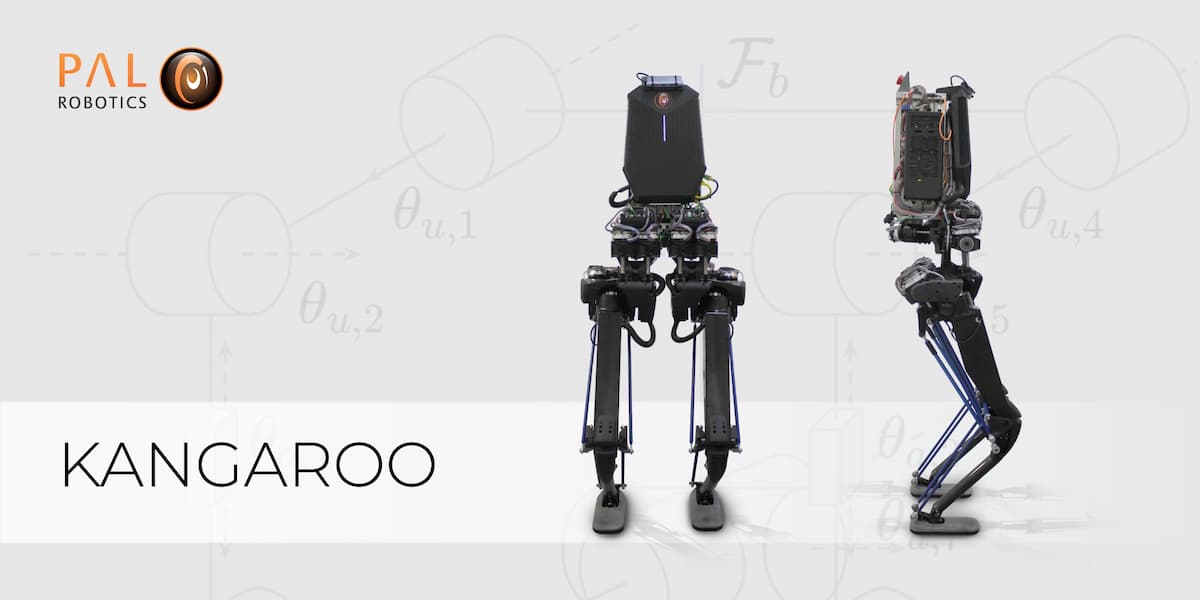Kangaroo robot – The most recent news
The latest advancements in robot locomotion have recently showcased the dynamic capabilities demonstrated by some biped robots outperforming human capabilities. The expectation is to have those kinds of platforms in our daily lives soon, but this comes at the price of having robust hardware that could sustain impacts and reactive control to plan and execute those motions in unstructured scenarios.
The hardware design of bipedal humanoid robots has been developed to be robust and resilient to impacts, as well as lightweight and efficient for dynamic movements. At the same time, planning and control architectures permit now to generate and control dynamic, contact-rich motions employing the dynamics and the full body of the system. Following this trend, PAL Robotics has designed and built a new robot based on a complete novel design using ball-screw actuators. The platform’s name is Kangaroo and here we will showcase the latest results achieved with the platform.
Read more about our latest updates in legged platforms at ICRA 2022.
The tradition of biped humanoid robots at PAL Robotics
PAL Robotics has the mission of enhancing people’s quality of life through Service Robotics by providing robotics products and services that range from commercial to research platforms. The latter includes our well-known biped humanoid robots, REEM-C and TALOS. These platforms allow testing the latest advances in locomotion-related research. We are currently going one step further in the ongoing development of Kangaroo robust biped research platform to provide a humanoid robot that is capable of performing highly dynamic motions and is resilient to impacts.
Background to the creation of the Kangaroo platform
Dynamic manoeuvres such as jumping, hopping, running, or spinning in the air produce high levels of impact on the robot, which needs to counteract and absorb all the energy produced by those impacts. In classical designs, the impact is absorbed directly by the mechanism causing damage to the electronics, sensors, or the mechanism itself. High-frequency controllers could foster handling minor impacts, but the only way to resist high impacts and falls is through the right combination of software and hardware.
In parallel, we need powerful joints that can provide enough torque and speed to perform agile manoeuvres. For this purpose, at PAL Robotics, we have designed a lightweight and low inertia platform with low joint friction that can provide high torque and speed. This novel kinematic design has been optimized to be efficient, activating only a single joint for jumping vertically or squatting. This led to a complete change in the paradigm of the previous biped robots at PAL Robotics.
Moreover, we can proudly say Kangaroo has been developed fully in-house, as the electronics have been designed and manufactured by PAL Robotics, to optimize the torque control previously presented in TALOS, and to make it accessible for Kangaroo researchers.
Latest developments on the Kangaroo robot
There are a couple of recent developments on the Kangaroo robot that we presented at ICRA 2022 (The International Conference on Robotics and Automation).
The first one showcases Kangaroo robot jumping in Torque control running the Whole Body Inverse Dynamics Controller (WBID) from PAL Robotics.
The second one presents the software that allows controlling this novel design where linear actuators generate rotary motions leading to non-linear transformations.
On the Hardware Design and Control Architecture of the Humanoid Robot Kangaroo
In this short paper, we present Kangaroo performing jumps using the Whole Body Inverse Dynamics Controller (WBID) from PAL robotics, demonstrating the robustness and resilience of the platform.
We also present our methodology, in which we show how we can reduce the complexity of 76 DoF (12 actuated and 64 underactuated) into a reduced model of 16 DoF (12 actuated and 4 underactuated). We briefly explain how we enforce the ros_control interface to define custom transmissions that allow us to control in joint space while sending torques to the motors.
Finally, we present the whole pipeline used to perform Operational Space Inverse Dynamics (OSID) to perform successful jumps in the robot.
Find out more about our research in Kangaroo’s control and planning and check the research paper by HAL Open Science.
Whole-Body Kinematics Modelling in presence of Closed-Linkages
This short paper presents preliminary studies and results on a generic software to control the robot in the presence of multiple closed and parallel linkages. These kinematic structures are known to have superior mechanical performance at the cost of increased modelling and control complexity.
We introduce the methodology to handle such complexity applied to the Kangaroo robot, considering whole-body formulation based on quadratic programming optimization. The presented approach is finally validated in simulation and with experiments performed on the real platform.
If you are interested, read our poster on whole-body kinematics modelling in Kangaroo robot as well as the research paper by HAL Open Science.
Find out more about this research here as a poster and as a research paper.
If you would like to find out more about PAL Robotics and our humanoid biped research platforms including the progress of Kangaroo, visit our blog to keep updated and to ask any questions, don’t hesitate to visit our contact page.
